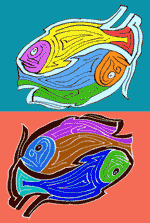|
Shirtboards
Each Wednesday our shirts came back from the laundry folded around pieces of cardboard, and the other kids in the boarding school brought their shirtboards to me to have their portraits drawn. The cardboard was shiny white on one side, matt gray on the other, and at first I drew on the white side but then I took to drawing on the gray, where I could use chalk to make highlights, and then I drew with colored pastels.
You can “paint” with pastels, blending them with the fingertip. I learned that pastels are more durable than oils, being almost pure pigment. But they are fragile in that they easily get rubbed off, so I learned to blow fixative spray with an angled tube. This did not always work well. One time my puff blew away the whole top layer of my friend's face, returning the picture to the state in which I had blocked it out, sharply separated swaths of red and yellow — a more interesting effect, though at the time I didn't appreciate it and neither did my friend.
Likeness switches on at a certain moment, or fails to. I had to toil at the little calculations that achieved likeness, while what I was more interested in were the patterns.
The profile view of a face is far easiest because no symmetry to worry about, the full-on view harder, in-between angles richest in information but hardest of all because the slightest movement destroys every pattern just as you start to grasp it. Later when I had to draw people's portraits I tried to get away with advising them that they looked best in profile. Not only was this easiest but they didn't know what their profiles looked like.
BACK
|
